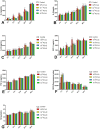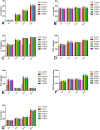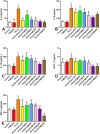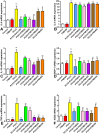Normal butanol fraction of Polygonum hydropiper L. flavonoids reduces inflammation caused by PCV2 infections in cell and mouse models
- PMID: 39968105
- PMCID: PMC11833999
- DOI: 10.3389/fvets.2025.1539448
Normal butanol fraction of Polygonum hydropiper L. flavonoids reduces inflammation caused by PCV2 infections in cell and mouse models
Abstract
Introduction: The normal butanol fraction of Polygonum hydropiper L. flavonoids (FNB) exhibits significant anti-inflammatory effects. This study investigated FNB's impact on inflammatory responses induced by Porcine circovirus type 2 (PCV2) in cell and mouse models.
Methods: An inflammatory model was established in RAW264.7 cells infected with varying PCV2 concentrations. And assigning both RAW264.7 cells and 108 SPF-grade KM mice to Control, PCV2, Rutin, and various dosages of FNB groups. Inflammatory factors such as Monocyte Chemoattractant Protein-1 (MCP-1), interleukin-6 (IL-6), IL-8, IL-10, Tumor Necrosis Factor-alpha (TNF-α), Reactive Oxygen Species (ROS), and Nitric Oxide (NO) were quantified using ELISA, RT-qPCR and immunohistochemistry.
Results: Results showed that a PCV2 titer of 104.5 TCID50/0.1 mL when applied to RAW264.7 cells effectively established an in vitro inflammatory model at 12 and 24 h post-infection. Following PCV2 infection, all the inflammatory factors displayed a significant increased both in culture supernatant and intracellular mRNA expression levels (p < 0.05 or p < 0.01), but these levels were reduced by FNB treatment (p < 0.05 or p < 0.01). In mouse sera post-PCV2 infection also showed elevated levels of IL-6, IL-8 IL-10, TNF-α, and MCP-1 (p < 0.05 or p < 0.01). Additionally, mRNA and protein levels for TNF-α, IL-8, IL-10, IL-6, and iNOS rose significantly in lung tissues (p < 0.01) but decreased with FNB treatment (p < 0.05 or p < 0.01).
Discussion: These findings suggest that FNB reduces inflammatory factor production and modulates the inflammatory response triggered by PCV2 infection, potentially enhancing host resistance against it.
Keywords: RAW264.7 cells; inflammatory response; model establishment; normal butanol fraction of Polygonum hydropiper L. flavonoids; porcine circovirus type 2.
Copyright © 2025 Wei, Zhou, Zhao, Chen, Wang, Yu, Wei and Hu.
Conflict of interest statement
The authors declare that the research was conducted in the absence of any commercial or financial relationships that could be construed as a potential conflict of interest.
Figures







Similar articles
-
An ethyl acetate fraction of flavonoids from Polygonum hydropiper L. exhibits an anti-inflammatory activity in PCV2-infected porcine alveolar macrophages via PI3K/Akt and NF-κB pathways.Vet Res Forum. 2022 Sep;13(3):339-347. doi: 10.30466/vrf.2021.137675.3070. Epub 2022 Sep 15. Vet Res Forum. 2022. PMID: 36320309 Free PMC article.
-
Flavonoids from Polygonum hydropiper L. regulate PCV2-induced oxidative stress of RAW264.7 cells via Pi3k/AKT and Nrf2/HO-1 signaling pathways.Sci Rep. 2025 Aug 8;15(1):29112. doi: 10.1038/s41598-025-14362-9. Sci Rep. 2025. PMID: 40781346 Free PMC article.
-
Flavonoids of Polygonum hydropiper L. attenuates lipopolysaccharide-induced inflammatory injury via suppressing phosphorylation in MAPKs pathways.BMC Complement Altern Med. 2016 Jan 22;16:25. doi: 10.1186/s12906-016-1001-8. BMC Complement Altern Med. 2016. PMID: 26801102 Free PMC article.
-
Ethyl acetate fraction of flavonoids from Polygonum hydropiper L. modulates pseudorabies virus-induced inflammation in RAW264.7 cells via the nuclear factor-kappa B and mitogen-activated protein kinase pathways.J Vet Med Sci. 2020 Dec 26;82(12):1781-1792. doi: 10.1292/jvms.20-0263. Epub 2020 Oct 1. J Vet Med Sci. 2020. PMID: 32999131 Free PMC article.
-
Coinfection with Porcine Circovirus Type 2 (PCV2) and Streptococcus suis Serotype 2 (SS2) Enhances the Survival of SS2 in Swine Tracheal Epithelial Cells by Decreasing Reactive Oxygen Species Production.Infect Immun. 2020 Oct 19;88(11):e00537-20. doi: 10.1128/IAI.00537-20. Print 2020 Oct 19. Infect Immun. 2020. PMID: 32868342 Free PMC article.
Cited by
-
Synergistic effects of Chinese herbal formula combined with Microcin J25 against Escherichia coli and Salmonella in calf diarrhea and clinical evaluation of preventive and therapeutic effects in the Ningxia region.Front Vet Sci. 2025 Jul 8;12:1619420. doi: 10.3389/fvets.2025.1619420. eCollection 2025. Front Vet Sci. 2025. PMID: 40697642 Free PMC article.
References
-
- Choi CY, Rho SB, Kim HS, Han J, Bae J, Lee SJ, et al. . The ORF3 protein of porcine circovirus type 2 promotes secretion of IL-6 and IL-8 in porcine epithelial cells by facilitating proteasomal degradation of regulator of G protein signalling 16 through physical interaction. J Gen Virol. (2015) 96:1098–108. 10.1099/vir.0.000046 - DOI - PubMed
LinkOut - more resources
Full Text Sources
Research Materials
Miscellaneous

